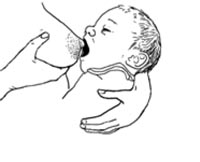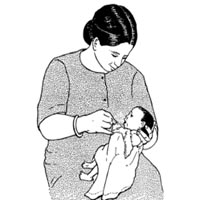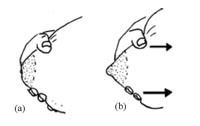
The breast milk produced by the mothers of preterm babies is even more nutritious than the milk produced by mothers whose babies were born at full term. Therefore, a preterm mother's milk is the best milk for the preterm or low birth weight baby, and no other milk can replace its benefits.

During the first week of the baby's life, the mother needs extra support from you and from the family to encourage her to initiate exclusive breastfeeding and maintain it until her tiny baby can suckle without any problem. Babies born between 34-36 weeks of gestation can usually suckle breast milk adequately, but very preterm babies may have difficulty breastfeeding.
Breastfeeding in a very preterm baby is a challenge. The frequency of feeding should be every two hours, including through the night. If babies born before 34 weeks cannot suckle adequately, they can be fed expressed breast milk using a small, very clean cup (We describe how to do this in the next section.)
Tiny or early babies who can suckle breast milk may also need feeding with additional expressed breast milk from a cup occasionally, to make sure they are getting enough nourishment. All babies who are on cup feeding have to be given around 60 ml/kg/day (that is 60 ml of breast milk for every kilogramme of the baby's weight every day) and Increase this by 20 ml/kg/day as the baby demands more feeding.
Extremely preterm babies born before 32 weeks of gestation may not be able to breastfeed at all and need to be started on intravenous fluids. This is one of the reasons why all babies less than 32 weeks of gestation should be referred to health facilities immediately.
Express a few drops of milk on the baby's lip to help the baby start nursing. Offer the whole breast, not just the nipple so that the baby can get a good mouthful (Figure 7.2). Give the baby short rests during a breastfeeding; suckling is hard work for a preterm or tiny baby. If the baby coughs, gags, or spits up milk when starting to breastfeed, the milk may be spurting out too fast for the baby.
Teach the mother to take the baby off the breast if this happens. Hold the baby against her chest until the baby can breathe well again. Then put it back to the breast after the first gush of milk has passed.
If the preterm baby does not have enough energy to suck for long, or its sucking reflex is not strong enough, teach the mother how to express her breast milk by hand and then feed it to the baby from a cup.
Expressing breast milk can take 20-30 minutes or longer to start with, but it gets quicker with practice. First tell the mother to wash her hands and her breasts with soap and water, and dry them with a very clean towel. Then prepare a cleaned and boiled cup or jar with a wide opening. If she is unable to boil the whole container, pour some boiling water into it and leave it there until just before she is ready to put milk into it; then pour the water away. This will keep the milk safe from bacteria.

The mother should sit comfortably and lean slightly towards the container. Show her how to hold the breast in a "C-hold" (her hand is shaped like a big letter C; (Figure 7.3a). Press the thumb and fingers back toward the chest wall (Figure 7.3b), then roll the thumb forward as if taking a thumbprint, so that milk is expressed from all areas of the breast. Express the milk from one breast for at least three to four minutes until the flow slows and then shift to the other breast.

Breast milk can be saved at room temperature for up to six hours if the room is not very hot and the milk is stored in a sterilised container. Or it can be kept for a longer time in a refrigerator if the mother has one. Wherever it is stored, the milk must be warmed to body temperature before it is given to the baby. To warm up the stored breast milk, put the container to stand for a while in a bowl of warm water. Never boil breast milk!. Boiling destroys nutrients and antibodies.
Show the mother and other family members how to hold the baby closely sitting a little upright. Hold a small clean cup half-filled with expressed breast milk to the baby's lower lip (Figure 7.3). When the baby becomes awake and opens its mouth, keep the cup at the baby's lips letting the baby take the milk slowly. Give the baby time to swallow and rest between sips. When the baby takes enough and refuses any more, put the baby up to the shoulder and "burp" her or him by rubbing the baby's back to expel air that may have been swallowed with the milk.